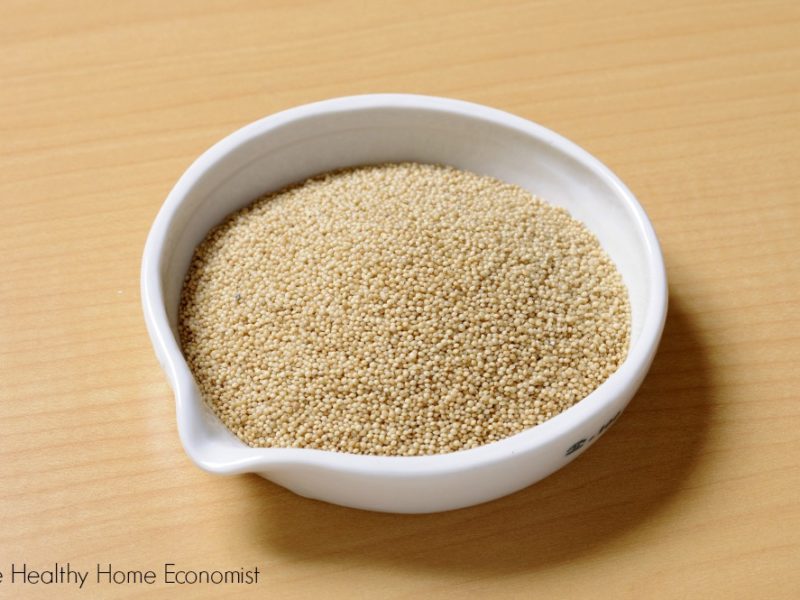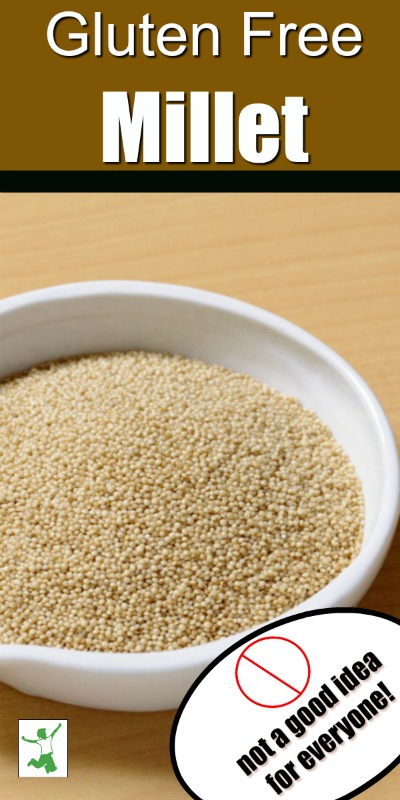Examination of why millet should optimally be eaten in moderation as a gluten-free whole grain in order to avoid disrupting hormone health.

Gluten allergies are clearly on the increase in our modern society. It seems like practically every other person I know these days has some sort of digestive issue that avoiding gluten would probably improve.
At the top of the list of gluten-containing foods is wheat. It is the indisputable, primary staple of the Western diet. Wheat is also the very foundation of the controversial USDA Food Pyramid.
Given how important bread and other wheat-based carbohydrates are to our society’s basic food requirements, it’s no wonder that folks seek a quick and easy substitute for wheat bread and wheat-based snacks when a gluten allergy or Celiac disease has been diagnosed.
Millet: Ancient Gluten-free Whole Grain
Enter millet. This ancient grain was cultivated in East Asia as far back as 10,000 years ago, according to archaeologists. Surprisingly, the cultivation of millet in prehistoric times was more prevalent than even rice, particularly in what is now China and the Korean peninsula.
Millet’s resistance to drought is perhaps the reason for its popularity in ancient times and its spread to Europe by 5000 B.C.
Despite the 5000 years cultivating this whole grain as a staple food, millet porridge is considered a traditional food in Russia as well as China. Use of millet is also widespread in Africa, like gluten-free teff, likely due to the drought-prone climate.
Millet Bread: Logical Substitute for Wheat
The protein structure of millet is quite similar to wheat. The one glaring exception is that millet is a gluten-free grain. Wheat contains copious amounts of this hard to digest plant protein.
When plain millet flour is used for baking bread (as opposed to homemade gluten-free flour or a healthy gluten-free flour mix from the store), the resulting loaf is light, white, and quite similar in texture to wheat bread. As a result, people who wish to avoid gluten tend to immediately gravitate to millet bread as the most logical and palatable substitute.
Millet bread is extremely popular in health food stores. Sami’s Bakery and Deland Bakery are two local bakeries that sell an absolute ton of millet bread to these stores around my local metro area.
I recently corresponded with a person up the East Coast of the USA who was consuming a lot of the millet/flax chips as an alternative to wheat-based snacks and had no idea of the potential health risks from consuming so much millet.
It was this discussion that led me to write this blog and warn folks about the dangers of consuming too much millet!
Potent Goitrogens
While millet does not contain gluten, it does contain goitrogens. These are substances that suppress thyroid activity and can lead to goiter. This condition involves enlargement of this very important gland which resides in the throat. Low iodine intake can also lead to goiter for those who rely on millet as a staple according to the Journal of Endocrinology and Metabolism.
Hypothyroidism is a serious and sometimes debilitating condition. It accompanies a weak or enlarged thyroid such as what occurs with goiter. Depression, difficulty losing weight, loss of hair, cold hands/feet, and fatigue are common hypothyroid symptoms. By some estimates, hypothyroidism is at epidemic proportions in Western society. (1)
Goitrogens in foods that contain them are usually reduced by cooking such as cruciferous vegetables like broccoli. However, cooking actually increases the goitrogenic effect of millet! Incidentally, the same effect occurs when fermenting soy.
Therefore, when folks begin eating large amounts of millet bread with a wholesale switch over from wheat, the thyroid suppressing effects of this simple dietary change can be profound. Injuring the thyroid can have a cascade effect on other glands as well. For example, those suffering from adrenal fatigue many times have thyroid issues as well.
Moderation is Critical
Protect your thyroid at all costs! It is a real challenge to unwind the effects of hypothyroidism once this vital gland is weakened or enlarged. Don’t take any chances with your thyroid health by consuming large amounts of millet bread or millet based snacks.
If gluten and/or wheat is a problem, then simply reduce bread consumption. Alternatively, use another grain that is both gluten-free and non-goitrogenic such as rice, oats or teff. Be sure to get quality, though, as rice is frequently high in arsenic.
Alternatively, try using grain-like gluten-free foods such as highly nutritious buckwheat, amaranth, or the starchy tuber cassava. They are excellent for baking too!
Millet bread consumption is fine in moderation if your thyroid is healthy – just don’t overdo it!
Given how difficult it is in modern society to maintain thyroid and overall glandular health, taking a chance by eating a lot of millet bread is a risky proposition indeed.
Traditional peoples did not have the constant stresses and strains on their glands like modern people do.
For example, they did not have to contend with pollution of their food, water, air and overall environment.
Therefore, we must be overprotective of our thyroid health. This includes avoiding regular consumption of foods that might impair it in any way.

Millet Alternatives That Preserve Thyroid Function
If you have thyroid issues and need alternatives to millet, here is a list of the healthiest options to consider.
- Einkorn Benefits (contains “good gluten“)
- Teff Benefits
- Yuca Root Benefits
- Arrowroot Benefits
- Wild Rice Benefits
- Farro (great if only modern wheat is the problem)








The salient fact omitted in this post is that the goitrogen is in the bran. It the traditional preparation of African ogi, millet porridge, the millet is soaked, ground wet, and passed through a cloth to sieve out the bran. The liquid is then fermented and cooked into porridge. As with most foods, look to traditional preparations to learn the healthiest ways to consume them.
Personally, I love millet and have eaten it daily for several years to no ill effect. I find it the most digestible of all grains. My favorite way to serve it is with a raw egg yolk, a spoonful of red palm oil, and paprika. I soak a jar of millet overnight, blend it the blender, pour it through an unbleached cotton bag that hangs over a jar to sieve out the bran. The jar sits, covered with a piece of cloth and a rubber band, on the counter to ferment and be used as needed.
Thanks for popping over from Kelly the Kitchen Kop! Kelly is definitely one of my favorite people and I am a big fan of her blog!
Wow! I knew that millet is goitrogenic, but I didn't know about the increased goitrogens with cooking thing. Millet is a guilty pleasure of mine- but I guess I'll be tossing out what's left in my bag (family history of hypothyroidism- hence why I know about goitrogens).
For those who are interested- other goitrogens are cruciferous vegetables such as cabbage, spinach, broccoli, and cauliflower (I think there are others?), in which the goitrogens are reduced (but not eliminated) in cooking. And soy- which cooking does not reduce, though fermenting does. So, don't eat tofu, but tempeh and real fermented soy sauce are ok in moderation. I can't remember if miso counts or not, since it's a by-product of fermenting the soy sauce…
So- fermented soy= ok, cooked soy= bad, cooked veggies= ok, fermented veggies= bad (in other words, only eat sauerkraut if you also cook it!).
Thank you so much for this post! I really thought that cooking the millet would make it relatively ok. :-/ (I came over from Kelly the Kitchen Kop's link)
There is no way you can say that fermented veggies are bad! Have you read Donna Gates and Body Ecology? Eating Raw and including fermented veggies is the way to go and has changed my life.
Hi Amy!!!! Thanks for commenting. You were actually the inspiration for this blog – when you mentioned that you ate those Sami's bakery millet chips on our walk around the river. I couldn't remember who it was exactly as I get so many email questions everything tends to blur together sometimes. I am so glad you know now – those chips are so delish but I would hate for it to make your thyroid worse. Hope to see you again when I am up that way in the future!!
Hi, Sarah.
It was nice to meet you in Rockford last week!
Thanks for the info about millet.
I do have low thyroid issues and never knew this about millet.
God bless,
Amy
Spelt is one of the best choices for grains, I think. It is non hybridized unlike wheat, much lower in gluten and truly delicious. Sprouted organic spelt flour is a wonderful use for this healthy grain.
Thanks again, Sarah, so good to know this. We have to be very careful with grains, which are not the ideal food for us humans.
We eat mainly animal foods, but we use sprouted organic Spelt flour for what baking we do. Do you know anything bad about Spelt in this form?
This information is very helpful. I haven't jumped onto the millet bandwagon, but this is a good reminder that everything should be eaten in moderation.
Most GF people seem to do better without appreciable amounts of any grain in their diet. Rice is the least problematic. But don't try to reproduce the wheat-based diet with other grains.
Adding sea vegetables to a meal with millet would help neutralize the goitrogenic effect though.
Through Rami Nagel, I learned that rice is high in phytates as well and soaking it doesn’t help much. He did say you could make a rice starter by saving some of the liquid each time you soak it, which helps break down the phytates. But rice doesn’t seem to be a good alternative and it seems to be the most used by those who are gluten-free. It’s also probably one of the starchiest grains.
The book mentions brown rice as the rice high phytates, not, white rice. White rice is okay to consume and won’t deplete your body of minerals.
All.
I have been using whole organic brown rice and brown rice pasta as a substitute for general carbs and pasta for decades, and I am thriving. I eat a vegan, all organic Mediterranean style diet with lots of organic legumes (mainly lentils and mung beans) brown rice, brown rice pasta, a -lot- of cooked kale and collards, small amounts of potatoes, leeks, olive oil and flax oil after cooking, tomatoes, and a little tamari, with all of these in most of my meals; and I am doing just fine.
So eat brown rice to your heart’s content.
Unfortunately, fermentation appears to have no effect on millet's goitrogenic effect either. If you have normal thyroid function, then you can continue to enjoy it in strict moderation, but if you suspect any glandular issues, then do not eat it at all. I myself have no thyroid issues, but still will not eat it as I think the stresses of modern life already pose a heavy burden to the thryoid even under the best of circumstances.